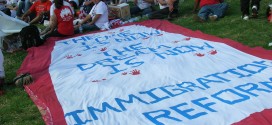By Tamara Treichel
The Philippines have come into the spotlight recently with Typhoon Haiyan lashing the Philippines in November and Filipino American Heritage Month being celebrated in October. But how are Filipinos faring in the United States, and in the metro DC area in particular?
Asian Fortune talked with five professionals, four of which are Filipino, both in the DC metro area and California about the growth of this particular group and the challenges and also exciting opportunities it faces.
The growth of the DC’s area’s Filipino population is in keeping with the overall increase in this population on a national level. According to the 2010 U.S. Census, Filipinos numbered over 3.4 million, including those who identified as more than one race. This was an increase of more than one million, or 44.5%, since the 2000 Census.

“According to the 2010 DC Asian Census Report, 12.78% of Asian Americans in Washington, DC are Filipinos. In general, the Asian American population has increased nearly 17.5% since the 2000 Decennial Census when Asian Americans represented 3.69% of the District’s population,” Soohyun Koo, executive director of the DC Mayor’s Office on Asian and Pacific Islander Affairs (OAPIA), said.
While California had the largest number of Filipinos as of 2010 (over 1.4 million), Virginia ranked No. 10 with 90,493.
Rodel Rodis, who taught Filipino American History at San Francisco State University, explained what is behind this growth. “The general poverty and lack of economic opportunities in the Philippines are the usual push suspects while the job opportunities in the U.S., despite the anemic recovery, and the presence of so many relatives as part of their support network in the U.S. are the pull factors,” he said.
With this growth come challenges associated with strong accents and discrimination, Rodis said.
In addition, many Filipinos are still especially disadvantaged by the U.S. immigration system because they have to endure extremely long waits to immigrate to the U.S., as Gem P. Daus and Erwin de Leon demonstrated with data in a paper for the Filipino Leaders Briefings in Washington, DC (June 2012).
In DC, Koo said that Filipinos face many of the same problems other immigrant populations face: “Filipinos in DC may experience language and cultural barriers when accessing public resources or services that are available to them; they may not be aware of such resources or may not feel such resources are suitable for them, leading to possible isolation from the general community,” she said.
“In addition, some Filipino teachers have been victims of foreign labor contracting fraud. OAPIA helps to ensure that language and cultural barriers are minimized for all AAPI residents, community members, and individuals who come to District government agencies for assistance, so that needs and concerns can be addressed to the fullest extent possible,” Koo said, adding that OAPIA is also helping the District’s Filipino community through grant funding and community outreach.
Yet in some respects, America’s Filipinos may have an easier time adjusting to the U.S. than other minority groups. “The advantages have to do with facility with English which is really the national language of the Philippines [next to Filipino] and the network of family and regional affiliations in helping to find jobs,” Rodis said.
Another factor may be that many Filipinos are Roman Catholics and many of their social activities are centered around the church. Catholicism is among the mainstream religions in the United States, which gives Filipinos an advantage with assimilating to this culture.
Maria Kang, a half-Filipina and half-Malaysian Chinese from California and a former pageant queen whose fondness for fitness made nationwide headlines recently, was confident that Filipina women have what it takes to succeed in the United States. “Filipina women are known to be strong-willed, family- and service-oriented, compassionate, faithful and beautiful. Those qualities will help them to succeed in the U.S.,” Kang said.
Also, Filipino Americans tend to be more politically active and engage in more community work than other Asian groups in the United States, according to the briefing paper authored by Daus and de Leon. This offers Filipinos a lot of exciting opportunities in a country as open and democratic as the U.S.
The reasons behind this community engagement may again be the facts that many Filipinos speak English well and have a strong sense of mission to serve and help others due to their Catholic faith.
Kang also commented on this for Asian Fortune. “There are many Lions Clubs in our area who have a large Filipino membership. Similar to other communities, the Filipino culture is very prevalent in care and hospitality fields like hospitals and nursing homes,” Kang said. Kang herself is very much involved in her local Sacramento, California community. She manages residential care home facilities and has founded a fitness non-profit organization called Fitness Without Borders, which has the motto “It takes a community to raise a fit child.”
This social activism of many Filipinos explains why there are many Filipino-American grassroots organizations in the DC metro area – non-profits, charities, sports, political and professional organizations.
One professional Filipino-American organization is the Filipino Young Professionals of DC Lizardo has seen membership in his organization grow. “Over the past 10 years, I think overall I’ve seen a lot more young professionals taking jobs in the metro DC area. Various industries have expanded significantly, particularly in information technology and consulting, and there are definitely more and more Filipino and Filipino Americans representing that population,” he told Asian Fortune. “I have also noticed more representation in the graduate student population as more Filipinos are pursuing advanced degrees and higher education.”
“The Filipino Young Professionals has, for over a decade, tried to serve as a resource for the Filipinos and Filipino Americans in metro DC,” Lizardo said. “We try to bring together the young professional population to serve as a network of individuals that can help one another in whatever capacity. We also serve as a resource to the Filipino community at large. This year in particular, we have placed more focus on working with the undergraduate and graduate students at the local universities,” he said.
“Through various events, activities, and in working with other groups, we have tried to connect these future leaders to the established organizations and resources available to them within the local community. As an organization we are trying to help facilitate change and advancement while at the same time providing a social atmosphere where we can all come together,” Lizardo said.
Another Filipino-American organization is the political organization Kaya-Filipino Americans for Progress, which has a DC chapter. Marita Etcubanez is the co-chair of the DC chapter, which has witnessed growth in its members. One of its main goals is to get more political engagement from the Filipino American community.
“We also engage in efforts to help build leadership within the Filipino American community. One of the signature projects for the DC Chapter of Kaya is our program geared towards the summer interns who come to Washington DC each year to take positions on the Hill, in executive agencies, and with advocacy organizations. Our Kaya Leadership Program seeks to provide a space for these students to meet with and learn from our members, many of whom are established professionals working in government and in the non-profit arena,” Etcubanez told Asian Fortune.
“In addition, Kaya engages in advocacy on issues impacting the Filipino American community, including work for Filipino World War II veterans and, since Filipinos are one of the communities most severely impacted by the broken immigration system, the continuing push for immigration reform,” she said. “Kaya has organized a number of fundraisers to support scholarships, non-profit organizations that serve the local community, and relief efforts in the Philippines.”
For his part, Lizardo told Asian Fortune that Filipino Young Professionals of DC has been trying to bring the DC Filipino community together, for example by helping those whose were recently devastated by Typhoon Haiyan. “We have two large events coming up and the expected turnout is already exceeding our expectations. Many non-Filipino organizations have reached out to us and have asked us how they can help and how they can contribute. We have become and established ourselves as a resource not just to Filipino, but to other organizations and to Filipinos back home,” Lizardo said.
“In light of the recent devastating natural disaster, it has been nice to see our community come together the way it has. It’s unfortunate that it takes such a horrific event for this to happen, but for the first time in a long time, I am actually seeing everyone coming together for a common good,” he said.
 Asian Fortune Your source for all things Asian American
Asian Fortune Your source for all things Asian American




2 comments
Pingback: Filipino Americans; Typhoon Haiyan; Filipino Young Professionals of D.C., Maria Kang, Asian Americans, relief efforts, KAYA
Pingback: D.C. Area’s Growing Filipino Population Rallies around Social Causes (Asian Fortune, December 6, 2013) | My Website